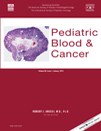Erratum: Essential erbB family phosphorylation in osteosarcoma as a target for CI-1033 inhibition
Hughes DP, Thomas DG, Giordano TJ, McDonagh KT, Baker LH. Essential erbB family phosphorylation in osteosarcoma as a target for CI-1033 inhibition. Pediatr Blood Cancer 2006;46(5):614–23.
Six years after performing the experiments published in this manuscript [1], DNA fingerprint analysis, together with in vivo and in vitro analyses, demonstrated that two of the cell lines used in this publication, OS 187 and COL, are not osteosarcoma cell lines. Both cell lines were first reported by our group [2]. All other cell lines used in this publication have since undergone DNA fingerprint analysis and have been shown to type correctly (for established lines SJSA and Saos-2) or to be unique (for primary OS line WOL).
Both cell lines have now been tested by DNA fingerprint analysis. For OS 187, every sample we have, including a vial frozen at passage 2 in our laboratory in 2002, has the same pattern as HCT 15, a common colon cancer cell line from the NCI60 cell panel. Further, in subsequent experiments from our group, we have been able to inject OS 187 into the cecum of NOD/SCID/IL2gR-/- mice, after which a tumor arose in the cecum and generated spontaneous metastasis to the liver (data not shown). Thus we believe that all results from OS 187 specifically reflect colon cancer biology and not osteosarcoma.
COL cells, after intra-tibial injection into NOD/SCID/IL2gR-/- mice, generated a pattern of tumor growth (no bone primary, but rather masses found in liver, skin, retro-orbital spaces, etc.) suggestive of neuroblastoma rather than osteosarcoma. Our further testing of COL, including evaluation of hematoxylin and eosin stained slides from in vivo tumors, examination of CD56 expression by western blot and fluorescence in situ hybridization demonstrating massive MYCN amplification, confirms that COL is a neuroblastoma and has just been reported [3].
Data from OS 187 and Col were included in figures 2, 3, 4, 5 and 6 of our 2006 publication in Pediatric Blood and Cancer [1]. Multiple cell lines were used for all experiments reported in this manuscript, including bone fide primary and established osteosarcoma cell lines whose identity has been confirmed by DNA fingerprinting. Reference to the cell lines evaluated is included in the legends of each figure. We believe that our main conclusion, i.e., that ERBB receptors are constitutively phosphorylated in osteosarcoma cells, providing essential survival and growth signals, continues to describe the biology of osteosarcoma accurately.




